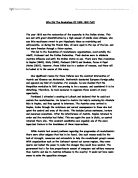What were the principal successes and failures of the revolutions in Italy 1820-31?
What were the principal successes and failures of the revolutions in Italy 1820-1831? Is it right to see these revolutions as a nationalist in nature?
To look at how and why a revolution fails you must consider why it occurred in the first place. The year 1815 saw a monumental change in the history of the Italian states with the Treaty of Paris turning back the progress of the Italian Political system and inverting it to the old obsolete absolutist monarchies the likes of which had been ruling the Italian peninsular for the past thousand years. Of course you can imagine much of the Italian populous were not too pleased with the obvious removal of progress to divert power back to a select few in the upper bracket of society. Interestingly enough however it was not the peasants of the peninsular who were ready to act against these reactionary demands even though they were supposedly being the most hard done by the Treaty, but of course a peasant is much too busy and perhaps not well enough educated to be able to devise a successful plot against the system. Rather, it was left to the middle-classes who began founding revolutionary Organisations, most notably the Adelfi, Carbonari and the Italian Federation.
Due to the diversity in Italian culture and political outlooks, at this time ‘Italy’ was only rarely used as a geographical expression, every different state had different revolutions occurring at any one time, however each revolution inspired another. For example, the Sicilians revolted against the Neapolitans which was then succeeded by the Neapolitans revolting against their own King, Ferdinand 1st. Due to his decision to stay and fight even though faced with an overwhelming number of enemies the King was forced to make concessions most notably the promise of a constitutional Monarchy. That appeased the majority of the Neapolitans however was not enough for the Sicilians who had begun their revolution with a view to independence, more of which will be discussed later. The general success of this Southern Revolution inspired the Carbonari, a secret revolutionary society with an eventual purpose of Italian Unification, to revolt in the Kingdom of Sardinia and the Northern States. As a result in Sardinia a constitutional monarchy would again be implemented as well as other reforms of liberalism. However all these achievements soon were quickly undone with the intervention of the Holy Alliance that would prove to be so key in halting any Liberal Ideals through-out Europe.








